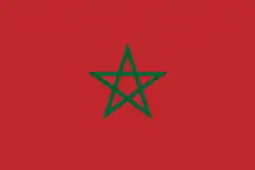Alaouite dynasty
The Alaouite dynasty, or Alawite dynasty (Arabic: سلالة العلويين الفيلاليين, Sulālat al-ʿAlawiyyīn al-Fīlālīyn), is the current Moroccan royal family. Sharif ibn Ali became Prince of Tafilalt in 1631. His son Mulay Al-Rashid (1664–1672) was able to unite and pacify the country. The Alaouites claim descent from a relative of prophet Muhammad and are the Arab ruling family of Morocco. The name Alaouites stems from caliph Ali son of Abu Taalib [15][16]
| Alaouite dynasty Alawite dynasty سلالة العلويين الفيلاليين | |
|---|---|
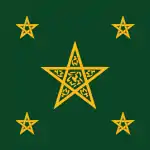 | |
| Country | Morocco |
| Founded | 1631 |
| Founder | Moulay Ali Cherif |
| Current head | Mohammad VI |
| Estate(s) | Morocco |
Sultanate of Morocco سلطنة المغرب | |||||||||||||||||
|---|---|---|---|---|---|---|---|---|---|---|---|---|---|---|---|---|---|
| 1665–1912 | |||||||||||||||||
.svg.png.webp) | |||||||||||||||||
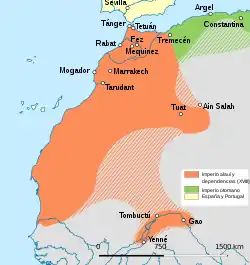 | |||||||||||||||||
| Capital and largest city | Fez | ||||||||||||||||
| Common languages | Arabic, Berber Languages | ||||||||||||||||
| Religion | Islam | ||||||||||||||||
| Demonym(s) | Moroccan | ||||||||||||||||
| Government | Islamic Sultanate | ||||||||||||||||
• 1631–1636 | Sharif Ibn Ali (Prince of Talifat) | ||||||||||||||||
• 1665–1672 | Al Rashid (First) | ||||||||||||||||
• 1908–1912 | Abdelhafid (Last) | ||||||||||||||||
| History | |||||||||||||||||
| 1665 | |||||||||||||||||
| 30 March 1912 | |||||||||||||||||
| Population | |||||||||||||||||
• Estimate | 6,000,000 (1900 estimates) | ||||||||||||||||
| Currency | Moroccan Rial | ||||||||||||||||
| ISO 3166 code | MA | ||||||||||||||||
| |||||||||||||||||
| Today part of | |||||||||||||||||
Kingdom of Morocco
| |
|---|---|
Motto: الله، الوطن، الملك (Arabic) ⴰⴽⵓⵛ, ⴰⵎⵓⵔ, ⴰⴳⵍⵍⵉⴷ (Standard Moroccan Tamazight) "God, Homeland, King" | |
Anthem: النشيد الوطني المغربي (Arabic) ⵉⵣⵍⵉ ⴰⵏⴰⵎⵓⵔ ⵏ ⵍⵎⵖⵔⵉⴱ (Standard Moroccan Tamazight) (English: "Cherifian Anthem") | |
.svg.png.webp) Dark green: Undisputed territory of Morocco Lighter green: Western Sahara, a territory claimed and occupied mostly by Morocco as its Southern Provinces[note 2] | |
| Capital | Rabat 34°02′N 6°51′W |
| Largest city | Casablanca 33°32′N 7°35′W |
| Official languages | |
| Spoken languages | |
| Foreign languages | English • Spanish[5] |
| Ethnic groups (2014[6]) |
|
| Religion |
|
| Demonym(s) | Moroccan |
| Government | Unitary parliamentary semi-constitutional monarchy[7] |
• King | Mohammed VI |
| Saadeddine Othmani | |
| Legislature | Parliament |
| House of Councillors | |
| House of Representatives | |
| Establishment | |
| 400 BC[8] | |
| 788 | |
| 1631 | |
| 30 March 1912 | |
| 7 April 1956 | |
| Area | |
• Total | 710,850 km2 (274,460 sq mi) or 446,550 km2[b] (39th or 57th) |
• Water (%) | 0.056 (250 km2) |
| Population | |
• 2020 estimate | 37,112,080 [9] (39th) |
• 2014 census | 33,848,242[10] |
• Density | 50.0/km2 (129.5/sq mi) |
| GDP (PPP) | 2019 estimate |
• Total | $332.358 billion[11] |
• Per capita | $9,339[11] |
| GDP (nominal) | 2019 estimate |
• Total | $122.458 billion[11] |
• Per capita | $3,441[11] |
| Gini (2015) | 40.3[12] medium |
| HDI (2019) | medium · 121st |
| Currency | Moroccan dirham (MAD) |
| Time zone | UTC+1[14] |
| Driving side | right |
| Calling code | +212 |
| ISO 3166 code | MA |
| Internet TLD | .ma المغرب. |
| |
| Historical Arab states and dynasties |
|---|
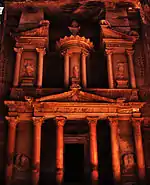 |
Part of a series on the |
|---|
| History of Morocco |
 |
|
|
| Royal family of Morocco |
|---|
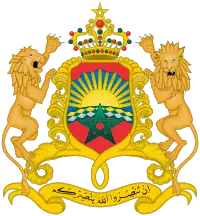 |
Princess Lalla Lamia
|
The Alaouites have ruled the Sultanate of Morocco, kept as Sultans during the French Protectorate of Morocco and the Spanish Protectorate of Morocco and ruled the Modern-day Kingdom of Morocco.
Centralised state
The organisation of the sultanate developed under Ismail Ibn Sharif (1672–1727), who, against the opposition of local tribes, began to create a unified state. Because the Alaouites had difficult relations with many of the country's Berber and Bedouin-Arab tribes, Isma'īl formed a new army of black slaves, the Black Guard. However, the unity of Morocco did not survive his death—in the ensuing power struggles the tribes became a political and military force once again.
During Muhammad III's reign (1757–1790) the kingdom was once again united and the administration reorganised. A renewed attempt at centralisation was abandoned, and the tribes were allowed to preserve their autonomy. Under Abderrahmane (1822–1859) Morocco fell under the influence of the European powers. After Morocco supported the Algerian independence movement of Emir Abd al-Qadir, it was attacked and defeated by the French in 1844 at the Battle of Isly and made to abandon its support.
European contact and the French protectorate
During the reigns of Muhammad IV (1859–1873) and Hassan I (1873–1894), the Alaouites tried to foster trading links, above all with European countries and the United States. The army and administration were also modernised to improve control over the Berber and Bedouin tribes. With the war against Spain (1859–1860) came direct involvement in European affairs. Although the independence of Morocco was guaranteed at the Treaty of Madrid (1880), the French gained ever greater influence. German attempts to counter this growing influence led to the First Moroccan Crisis of 1905–1906 and the Second Moroccan Crisis of 1911.
Eventually the Moroccans were forced to recognise the French protectorate through the Treaty of Fez, signed on December 3, 1912. At the same time the Rif area of northern Morocco was raised under Spanish control.
List of Alaouite rulers
From 1631 to 1666 the Alaouite dynasty ruled as princes of Tafilalt:
- Moulay Ali Cherif (1631–1635)
- Muhammad ibn Sharif (1635–1664)
- Al-Rashid (1664–1666)
In 1666 Mulay Al-Rashid was proclaimed Sultan of Morocco at Fez:
- Al-Rashid (1666–1672)
- Mawlay Ismail Ibn Sharif (1672–1727)
- Abu'l Abbas Ahmad II (1727–1728) (first time)
- Abdalmalik (1728)
- Abu'l Abbas Ahmad II (1728–1729) (second time)
- Abdallah (1729–1734) (first time)
- Ali (1734–1736)
- Abdallah (1736) (second time)
- Mohammed II (1736–1738)
- Al-Mostadi (1738–1740) (first time)
- Abdallah (1740–1741) (third time)
- Zin al-Abidin (1741)
- Abdallah (1741–1742) (fourth time)
- Al-Mostadi (1742–1743) (second time)
- Abdallah (1743–1747) (fifth time)
- Al-Mostadi (1747–1748) (third time)
- Abdallah (1748–1757) (sixth time)
- Mohammed III (1757–1790)
- Yazid (1790–1792)
- Mulay Suleiman (1792–1822)
- Abderrahmane (1822–1859)
- Mohammed IV (1859–1873)
- Hassan I (1873–1894)
- Abdelaziz (1894–1908)
- Abdelhafid (1908–1912)
Under the French protectorate (1912–1956):
- Yusef (1912–1927)
- King Mohammed V (1927–1961), changed title of ruler from Sultan to King in 1957. Deposed and exiled to Corsica and Madagascar (1953–1955).
- Mohammed Ben Aarafa, installed by France (1953–1955)
From Independence (1955 onwards):
- King Mohammed V (1955–1961)
- King Hassan II (1961–1999)
- King Mohammed VI (1999–present)
Timeline
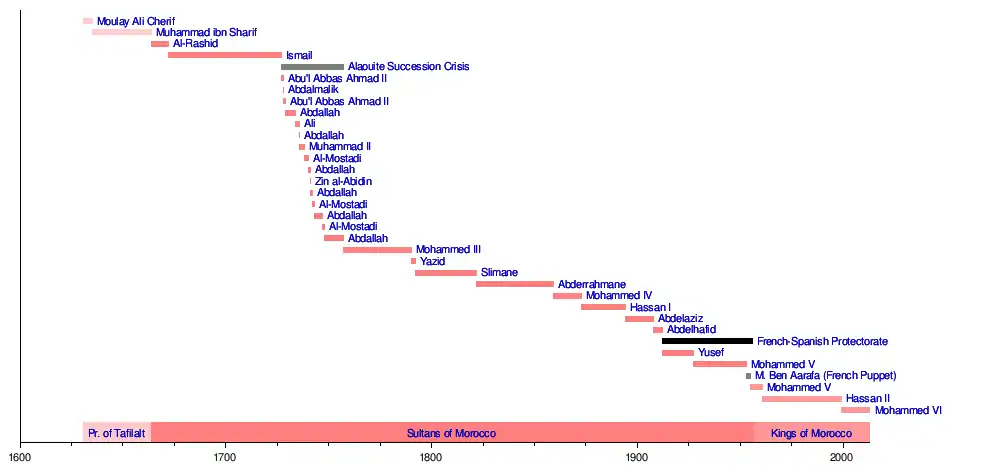
Family tree
| Hisham | |||||||||||||||||||||||||||||||||||||||||||||||||||||||||||||
ibn Hicham | |||||||||||||||||||||||||||||||||||||||||||||||||||||||||||||
| Aarafa | |||||||||||||||||||||||||||||||||||||||||||||||||||||||||||||
| Tahar | Ben Aarafa | ||||||||||||||||||||||||||||||||||||||||||||||||||||||||||||
3° spouse Lalla Bahia | 2° spouse Lalla Abla bint Tahar | ||||||||||||||||||||||||||||||||||||||||||||||||||||||||||||
| Lalla Fatima Zohra | Lalla Amina | 2° spouse Lalla Latifa Hammou | Lalla Malika | Lalla Nuzha | Lalla Aicha | Abdellah | |||||||||||||||||||||||||||||||||||||||||||||||||||||||
| Lalla Meryem | Lalla Asma | spouse Lalla Salma | Lalla Hasna | Rachid | Hicham | Ismail | |||||||||||||||||||||||||||||||||||||||||||||||||||||||
| Crown Prince Hassan | Lalla Khadija | ||||||||||||||||||||||||||||||||||||||||||||||||||||||||||||
See also
- Conflicts between the Regency of Algiers and the Cherifian Dynasties
- History of Morocco
- Order of Ouissam Alaouite
- List of Sunni Muslim dynasties
- Hashemites, Jordan’s ruling family that also claims descent from the Islamic prophet Muhammad
- Dâr-al-Makhzen, Rabat, official residence of the royal family.
- Line of succession to the Moroccan throne
- List of rulers of Morocco
Notes
- Solve the status issue under the leadership of United Nations' MINURSO[1]
- Solve the status issue under the leadership of United Nations' MINURSO[2]
- French language in Morocco is also used in official government documents and by the business community, although it has no official status: "French (often the language of business, government, and diplomacy)..."[3][4]
References
- "MANDATE". UNITED NATIONS.
- "MANDATE". UNITED NATIONS.
- "Morocco". World Factbook. Central Intelligence Agency.
- "Présentation du Maroc". Ministère de l’Europe et des Affaires étrangères (in French).
- "The teaching of English in Morocco".
- "Morocco". World Factbook. Central Intelligence Agency.
Ethnic groups: Arab-Berber 99%, other 1%
- "Constitution of the Kingdom of Morocco, I-1" (PDF). Archived from the original (PDF) on 18 May 2012. Retrieved 9 January 2013.
- Pennell, C. R. (2003). Morocco: From Empire to Independence. Oneworld. p. 6 to 8. ISBN 978-1-85168-303-1.
- "Morocco Population, 1960-2019 - knoema.com". Knoema. 2019. Retrieved 2 April 2020.
- "Rgbh 2014" (in French). HCP. 2014. Retrieved 17 October 2019.
- "Morocco". IMF.
- Africa's Development Dynamics 2018:Growth, Jobs and Inequalities. AUC/OECD. 2018. p. 179. Retrieved 18 December 2020.
- Human Development Report 2020 The Next Frontier: Human Development and the Anthropocene (PDF). United Nations Development Programme. 15 December 2020. pp. 343–346. ISBN 978-92-1-126442-5. Retrieved 16 December 2020.
- "Morocco Keeps Clocks Steady on GMT+1". 28 October 2018.
- Compagna, Lawrence (2019-03-06). Genealogy: Tools, Tricks and Tips for putting together your family tree. Candco Publishing, a division of the Candco Corporation.
- Rézette, Robert (1975). The Western Sahara and the Frontiers of Morocco. Nouvelles Editions Latines. p. 47.
Moulay Rachid who really founded the dynasty in 1664, was born in Tafilalet of a family that had come from Arabia
Further reading
- Waterbury, John. Commander of the Faithful
External links
— Royal house — House of Alaoui | ||
| Preceded by Saadi Dynasty |
Ruling house of Morocco 1666 – present |
Incumbent |
